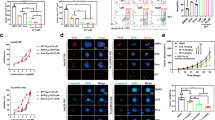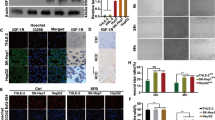Abstract
Rapamycin (RAPA) inhibits tumor growth and angiogenesis in hepatocellular carcinoma (HCC). The molecular mechanism underlying the antitumoral effects of RAPA remains unclear. Here we established a chemical-induced rat HCC model to investigate the signaling pathways mediating RAPA’s antitumor activity. We found that RAPA exposure significantly diminished tumor growth, angiogenesis, and metastasis of HCC. Meanwhile, the antitumor drug dramatically decreased expression of HIF-1alpha and VEGF, either at mRNA or protein levels. Moreover, the low-dose of RAPA (1.5 mg/kg/day) was effective enough to markedly inhibit tumor progression of HCC. The preliminary results suggested that the antitumoral effects of RAPA might be at least partially mediated through downregulation of HIF-1alpha and VEGF, and low-dose RAPA-based regimens exhibited a promising future in treatment of HCC.





Similar content being viewed by others
Abbreviations
- CsA:
-
Cyclosporine A
- DEN:
-
Diethylnitrosamine
- HCC:
-
Hepatocellular carcinoma
- HE:
-
Haematoxylin and eosin
- HIF-1alpha:
-
Hypoxia-inducible factor 1 alpha
- mTOR:
-
Mammalian target of rapamycin
- MVD:
-
Microvessel density
- NMOR:
-
N-nitrosomorpholine
- RAPA:
-
Rapamycin
- SD:
-
Spreque–Dawley
- VEGF:
-
Vascular endothelial growth factor
References
Parkin DM, Bray F, Ferlay J, Pisani P. Global cancer statistics, 2002. CA Cancer J Clin. 2005;55:74–108.
Yu MC, Yuan JM. Environmental factors and risk for hepatocellular carcinoma. Gastroenterology. 2004;127:S72–S78. doi:10.1016/j.gastro.2004.09.018.
Wang Z, Zhou J, Fan J, et al. Effect of rapamycin alone and in combination with sorafenib in an orthotopic model of human hepatocellular carcinoma. Clin Cancer Res. 2008;14:5124–5130. doi:10.1158/1078-0432.CCR-07-4774.
Huynh H, Chow PK, Palanisamy N, et al. Bevacizumab and rapamycin induce growth suppression in mouse models of hepatocellular carcinoma. J Hepatol. 2008;49:52–60. doi:10.1016/j.jhep.2008.02.022.
Guertin DA, Sabatini DM. Defining the role of mTOR in cancer. Cancer Cell. 2007;12:9–22. doi:10.1016/j.ccr.2007.05.008.
Vignot S, Faivre S, Aguirre D, Raymond E. mTOR-targeted therapy of cancer with rapamycin derivatives. Ann Oncol. 2005;16:525–537. doi:10.1093/annonc/mdi113.
Bu X, Le C, Jia F, et al. Synergistic effect of mTOR inhibitor rapamycin and fluorouracil in inducing apoptosis and cell senescence in hepatocarcinoma cells. Cancer Biol Ther. 2008;7:392–396.
Semela D, Piguet AC, Kolev M, et al. Vascular remodeling and antitumoral effects of mTOR inhibition in a rat model of hepatocellular carcinoma. J Hepatol. 2007;46:840–848. doi:10.1016/j.jhep.2006.11.021.
Guba M, von Breitenbuch P, Steinbauer M, et al. Rapamycin inhibits primary and metastatic tumor growth by antiangiogenesis: involvement of vascular endothelial growth factor. Nat Med. 2002;8:128–135. doi:10.1038/nm0202-128.
Basu A, Contreras AG, Datta D, et al. Overexpression of vascular endothelial growth factor and the development of post-transplantation cancer. Cancer Res. 2008;68:5689–5698. doi:10.1158/0008-5472.CAN-07-6603.
von Marschall Z, Cramer T. Höcker M, Finkenzeller G, Wiedenmann B, Rosewicz S: Dual mechanism of vascular endothelial growth factor upregulation by hypoxia in human hepatocellular carcinoma. Gut. 2001;48:87–96. doi:10.1136/gut.48.1.87.
Lee TK, Poon RT, Yuen AP, et al. Regulation of angiogenesis by Id-1 through hypoxia-inducible factor-1alpha-mediated vascular endothelial growth factor up-regulation in hepatocellular carcinoma. Clin Cancer Res. 2006;12:6910–6919. doi:10.1158/1078-0432.CCR-06-0489.
Yoshino H, Futakuchi M, Cho YM, et al. Modification of an in vivo lung metastasis model of hepatocellular carcinoma by low dose N-nitrosomorpholine and diethylnitrosamine. Clin Exp Metastasis. 2005;22:441–447. doi:10.1007/s10585-005-2807-9.
Weidner N, Semple JP, Welch WR, Folkman J. Tumor angiogenesis and metastasis–correlation in invasive breast carcinoma. N Engl J Med. 1991;324:1–8.
Zimmerman MA, Trotter JF, Wachs M, et al. Sirolimus-based immunosuppression following liver transplantation for hepatocellular carcinoma. Liver Transpl. 2008;14:633–638. doi:10.1002/lt.21420.
Mizukami Y, Kohgo Y, Chung DC. Hypoxia Inducible Factor-1 Independent Pathways in Tumor Angiogenesis. Clin Cancer Res. 2007;13:5670–5674. doi:10.1158/1078-0432.CCR-07-0111.
Mizukami Y, Fujiki K, Duerr EM, et al. Hypoxic regulation of vascular endothelial growth factor through the induction of phosphatidylinositol 3-kinase/Rho/ROCK and c-Myc. J Biol Chem. 2006;281:13957–13963. doi:10.1074/jbc.M511763200.
Cao Y, Li CY, Moeller BJ, et al. Observation of incipient tumor angiogenesis that is independent of hypoxia and hypoxia inducible factor-1 activation. Cancer Res. 2005;65:5498–5505. doi:10.1158/0008-5472.CAN-04-4553.
Mizukami Y, Li J, Zhang X, Zimmer MA, Iliopoulos O, Chung DC. Hypoxia-inducible factor-1-independent regulation of vascular endothelial growth factor by hypoxia in colon cancer. Cancer Res. 2004;64:1765–1772. doi:10.1158/0008-5472.CAN-03-3017.
Tanaka H, Yamamoto M, Hashimoto N, et al. Hypoxia-independent overexpression of hypoxia-inducible factor 1alpha as an early change in mouse hepatocarcinogenesis. Cancer Res. 2006;66:11263–11270. doi:10.1158/0008-5472.CAN-06-1699.
Yasuda S, Arii S, Mori A, et al. Hexokinase II and VEGF expression in liver tumors: correlation with hypoxia-inducible factor 1 alpha and its significance. J Hepatol. 2004;40:117–123. doi:10.1016/S0168-8278(03)00503-8.
Hojo M, Morimoto T, Maluccio M, et al. Cyclosporine induces cancer progression by a cell-autonomous mechanism. Nature. 1999;397:530–534. doi:10.1038/17401.
Iurlaro M, Vacca A, Minischetti M, et al. Antiangiogenesis by cyclosporine. Exp Hematol. 1998;26:1215–1222.
Aeder SE, Martin PM, Soh JW, Hussaini IM. PKC-eta mediates glioblastoma cell proliferation through the Akt and mTOR signaling pathways. Oncogene. 2004;23:9062–9069. doi:10.1038/sj.onc.1208093.
Leseux L, Laurent G, Laurent C, et al. PKC zeta mTOR pathway: a new target for rituximab therapy in follicular lymphoma. Blood. 2008;111:285–291. doi:10.1182/blood-2007-04-085092.
Moschella PC, Rao VU, McDermott PJ, Kuppuswamy D. Regulation of mTOR and S6K1 activation by the nPKC isoforms, PKCepsilon and PKCdelta, in adult cardiac muscle cells. J Mol Cell Cardiol. 2007;43:754–766. doi:10.1016/j.yjmcc.2007.09.015.
Acknowledgments
This research was supported by the National Natural Science Foundation of China (30772097), Anhui Provincial Natural Science Foundation (070413073), the Science and Technological Fund of Anhui Province for Outstanding Youth (08040106818), the Science and Technology Key Project of Anhui Province (07010302193), and the Anhui Provincial “115” Industrial Innovation Program. The authors declare no competing financial interests.
Author information
Authors and Affiliations
Corresponding author
Additional information
Wei Wang and Wei-Dong Jia contributed equally to this work as co–first authors.
Rights and permissions
About this article
Cite this article
Wang, W., Jia, WD., Xu, GL. et al. Antitumoral Activity of Rapamycin Mediated Through Inhibition of HIF-1alpha and VEGF in Hepatocellular Carcinoma. Dig Dis Sci 54, 2128–2136 (2009). https://doi.org/10.1007/s10620-008-0605-3
Received:
Accepted:
Published:
Issue Date:
DOI: https://doi.org/10.1007/s10620-008-0605-3




